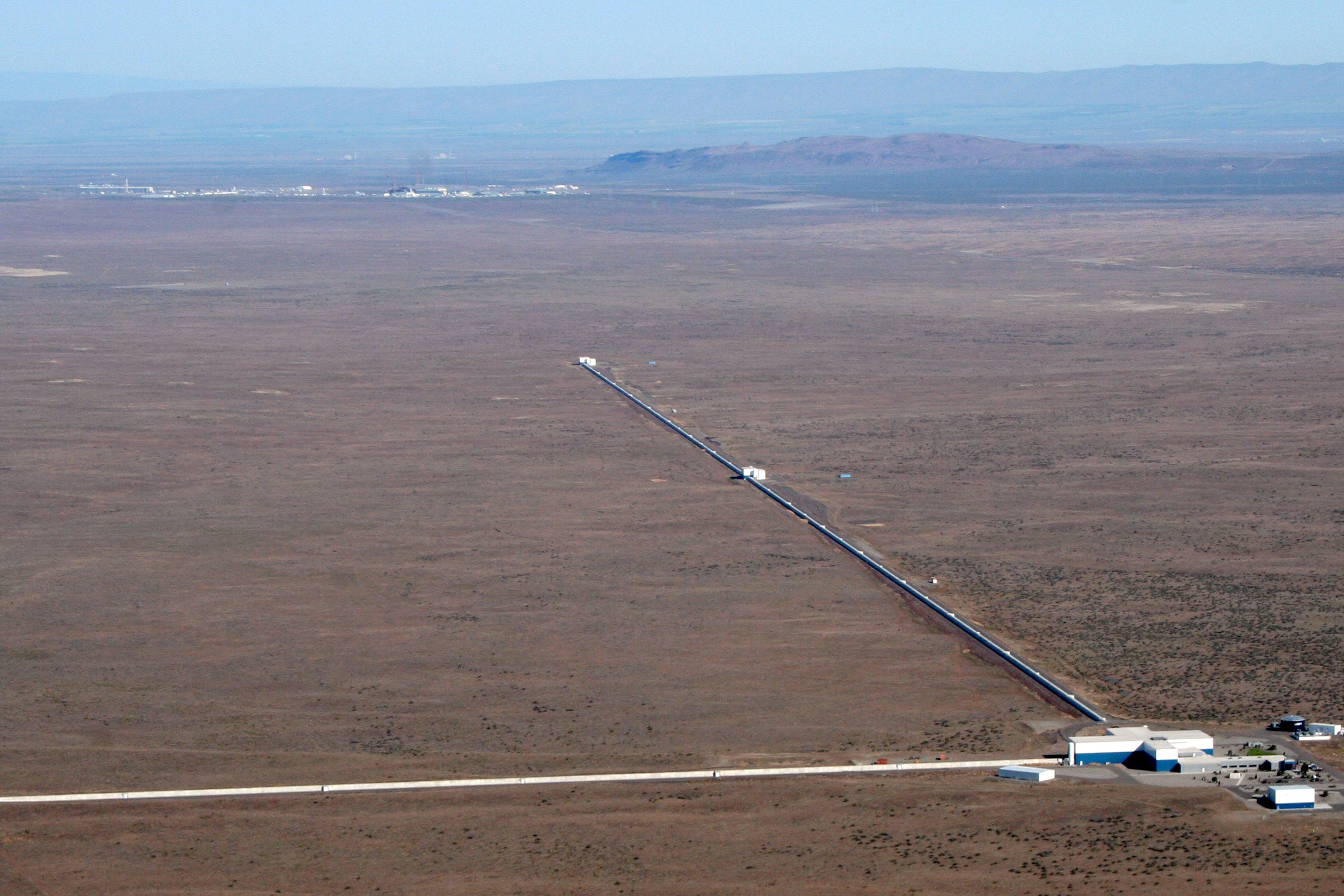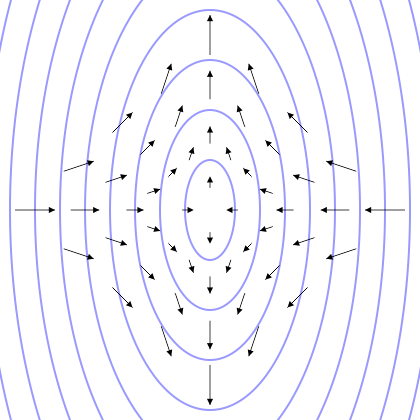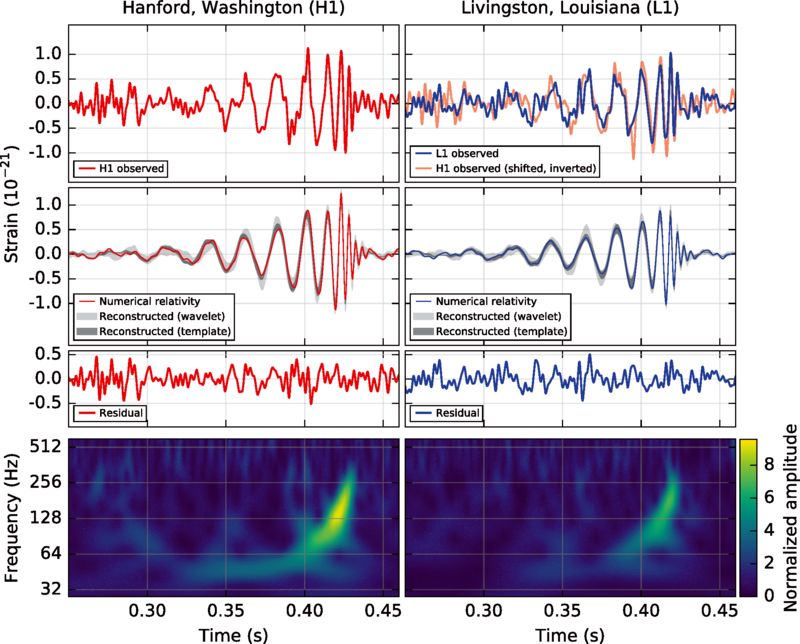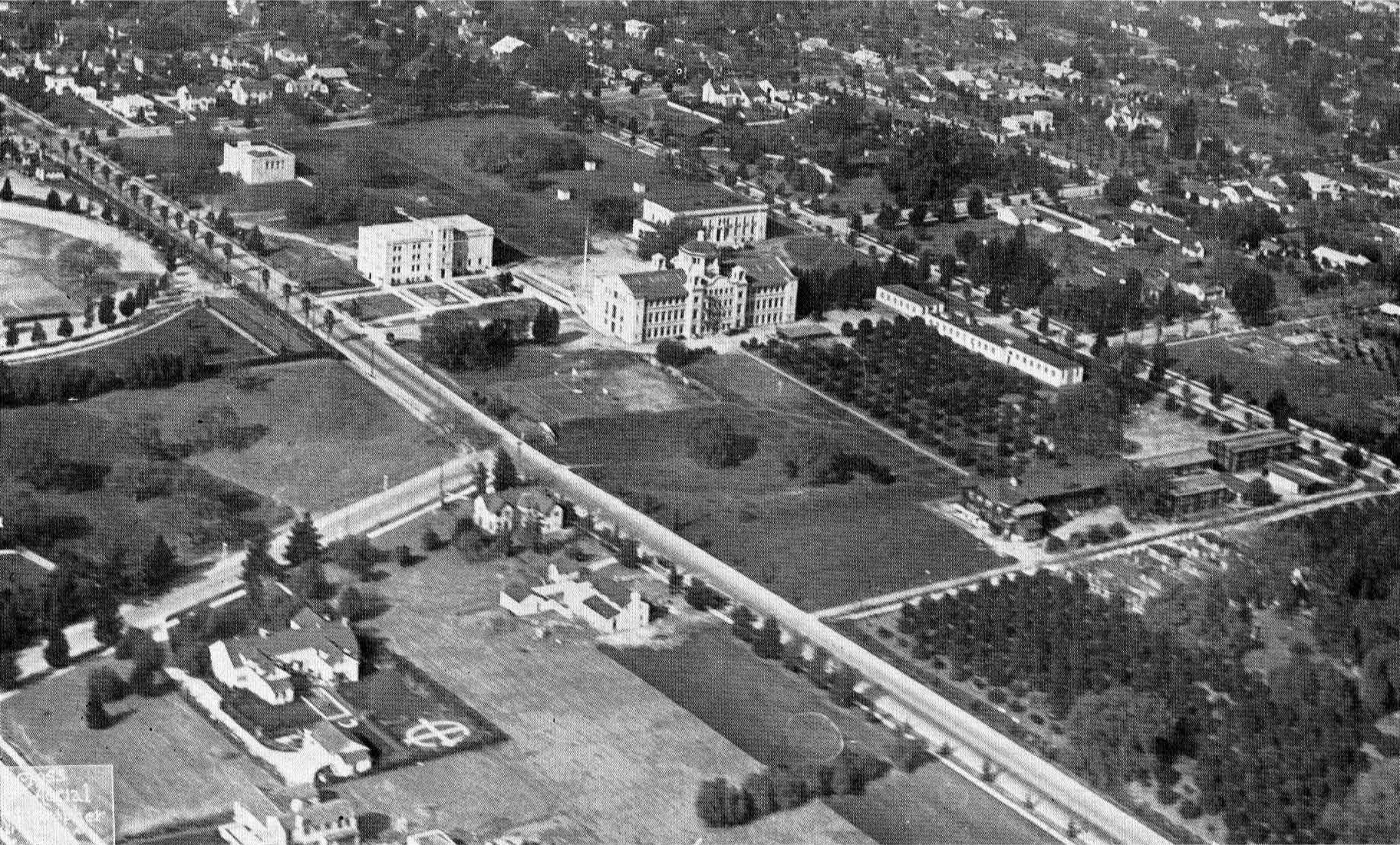|
LIGO
The Laser Interferometer Gravitational-Wave Observatory (LIGO) is a large-scale physics experiment and observatory designed to detect cosmic gravitational waves and to develop gravitational-wave observations as an astronomical tool. Prior to LIGO, all data about the universe has come in the form of light and other forms of electromagnetic radiation, from limited direct exploration on relatively nearby Solar System objects such as the Moon, Mars, Venus, Jupiter and their moons, asteroids etc, and from high energy cosmic particles. Initially, two large observatories were built in the United States with the aim of detecting gravitational waves by laser interferometry. Two additional, smaller gravity wave observatories are now operational in Japan KAGRA, (KAGRA) and Italy Virgo interferometer, (Virgo). The two LIGO observatories use mirrors spaced four kilometers apart to measure changes in length—over an effective span of 1120 km—of less than one ten-thousandth the charge radius, ... [...More Info...] [...Related Items...] OR: [Wikipedia] [Google] [Baidu] |
Virgo Interferometer
The Virgo interferometer is a large-scale scientific instrument near Pisa, Italy, for detecting gravitational waves. The detector is a Michelson interferometer, which can detect the minuscule length variations in its two arms induced by the passage of gravitational waves. The required precision is achieved using many systems to isolate it from the outside world, including keeping its mirrors and instrumentation in an ultra-high vacuum and suspending them using complex systems of Pendulum, pendula. Between its periodic observations, the detector is upgraded to increase its sensitivity. The observation runs are performed in collaboration with other similar detectors, including the two Laser Interferometer Gravitational-Wave Observatories (LIGO) in the United States and the Japanese Kamioka Gravitational Wave Detector (KAGRA), because cooperation between several detectors is crucial for detecting gravitational waves and pinpointing their origin. Virgo was conceived and built whe ... [...More Info...] [...Related Items...] OR: [Wikipedia] [Google] [Baidu] |
Einstein@Home
Einstein@Home is a volunteer computing project that searches for signals from spinning neutron stars in data from gravitational-wave detectors, from large radio telescopes, and from a gamma-ray telescope. Neutron stars are detected by their pulsed radio and gamma-ray emission as radio and/or gamma-ray pulsars. They also might be observable as continuous gravitational wave sources if they are rapidly spinning and non-axisymmetrically deformed. The project was officially launched on 19 February 2005 as part of the American Physical Society's contribution to the World Year of Physics 2005 event. Einstein@Home searches data from the LIGO gravitational-wave detectors. The project conducts the most sensitive all-sky searches for continuous gravitational waves. While no such signal has yet been detected, the upper limits set by Einstein@Home analyses provide astrophysical constraints on the Galactic population of spinning neutron stars. Einstein@Home also searches radio telescope da ... [...More Info...] [...Related Items...] OR: [Wikipedia] [Google] [Baidu] |
Gravitational Wave
Gravitational waves are oscillations of the gravitational field that Wave propagation, travel through space at the speed of light; they are generated by the relative motion of gravity, gravitating masses. They were proposed by Oliver Heaviside in 1893 and then later by Henri Poincaré in 1905 as the gravitational equivalent of Electromagnetic radiation, electromagnetic waves. In 1916, Albert Einstein demonstrated that gravitational waves result from his general theory of relativity as ripples in spacetime. Gravitational waves transport energy as gravitational radiation, a form of radiant energy similar to electromagnetic radiation. Newton's law of universal gravitation, part of classical mechanics, does not provide for their existence, instead asserting that gravity has instantaneous effect everywhere. Gravitational waves therefore stand as an important relativistic phenomenon that is absent from Newtonian physics. Gravitational-wave astronomy has the advantage that, unlike elec ... [...More Info...] [...Related Items...] OR: [Wikipedia] [Google] [Baidu] |
LIGO Scientific Collaboration
The LIGO Scientific Collaboration (LSC) is a scientific collaboration of international physics institutes and research groups dedicated to the search for gravitational waves. History The LSC was established in 1997, under the leadership of Barry Barish. Its mission is to ensure equal scientific opportunity for individual participants and institutions by organizing research, publications, and all other scientific activities, and it includes scientists from both LIGO Laboratory and collaborating institutions. Barish appointed Rainer Weiss as the first spokesperson. LSC members have access to the US-based Advanced LIGO detectors in Hanford, Washington and in Livingston, Louisiana, as well as the GEO 600 detector in Sarstedt, Germany. Under an agreement with the European Gravitational Observatory (EGO), LSC members also have access to data from the Virgo detector in Pisa, Italy. While the LSC and the Virgo Collaboration are separate organizations, they cooperate closely and ar ... [...More Info...] [...Related Items...] OR: [Wikipedia] [Google] [Baidu] |
Gravitational-wave Astronomy
Gravitational-wave astronomy is a subfield of astronomy concerned with the detection and study of gravitational waves emitted by astrophysical sources. Gravitational waves are minute distortions or ripples in spacetime caused by the acceleration of massive objects. They are produced by cataclysmic events such as the merger of binary black holes, the coalescence of binary neutron stars, supernova explosions and processes including those of the early universe shortly after the Big Bang. Studying them offers a new way to observe the universe, providing valuable insights into the behavior of matter under extreme conditions. Similar to electromagnetic radiation (such as light wave, radio wave, infrared radiation and X-rays) which involves transport of energy via propagation of electromagnetic field fluctuations, gravitational radiation involves fluctuations of the relatively weaker gravitational field. The existence of gravitational waves was first suggested by Oliver Heaviside in 1 ... [...More Info...] [...Related Items...] OR: [Wikipedia] [Google] [Baidu] |
Hanford Site
The Hanford Site is a decommissioned nuclear production complex operated by the United States federal government on the Columbia River in Benton County in the U.S. state of Washington. It has also been known as SiteW and the Hanford Nuclear Reservation. Established in 1943 as part of the Manhattan Project, the site was home to the Hanford Engineer Works and B Reactor, the first full-scale plutonium production reactor in the world. Plutonium manufactured at the site was used in the first atomic bomb, which was tested in the Trinity nuclear test, and in the Fat Man bomb used in the bombing of Nagasaki. During the Cold War, the project expanded to include nine nuclear reactors and five large plutonium processing complexes, which produced plutonium for most of the more than 60,000 weapons built for the U.S. nuclear arsenal. Nuclear technology developed rapidly during this period, and Hanford scientists produced major technological achievements. The town of Richland, e ... [...More Info...] [...Related Items...] OR: [Wikipedia] [Google] [Baidu] |
KAGRA
The Kamioka Gravitational Wave Detector (KAGRA) is a large interferometer designed to detect gravitational waves predicted by the general theory of relativity. KAGRA is a Michelson interferometer that is isolated from external disturbances: its mirrors and instrumentation are suspended and its laser beam operates in a vacuum. The instrument's two arms are three kilometres long and located underground at the Kamioka Observatory which is near the Kamioka section of the city of Hida in Gifu Prefecture, Japan. KAGRA is a project of the gravitational wave studies group at the Institute for Cosmic Ray Research (ICRR) of the University of Tokyo. It became operational on 25 February 2020, when it began data collection. It is Asia's first gravitational wave observatory, the first in the world built underground, and the first whose detector uses cryogenic mirrors. The cryogenic mirrors reduce the thermal noise and the underground location acts to significantly reduce the noise from seism ... [...More Info...] [...Related Items...] OR: [Wikipedia] [Google] [Baidu] |
Livingston, Louisiana
Livingston is the parish seat of Livingston Parish, Louisiana, United States. The population was 1,769 at the 2010 census. Livingston hosts one of the two LIGO gravitational wave detector sites, the other one being located in Hanford, Washington. History Like the parish, Livingston takes its name from the jurist Edward Livingston. Livingston was the site of a major train derailment (spilling about 200,000 gallons of chemicals) in 1982. On February 11, 2016, it was officially announced that the LIGO collaboration successfully made the first direct observation of gravitational waves in September 2015. Barry Barish, Kip Thorne and Rainer Weiss were awarded the 2017 Nobel Prize in Physics for leading this work. The communities of Doyle and Livingston, combined in 1955 to create the Town of Livingston. Doyle was established northeast of present-day Livingston in the late 1800's, located on Hog Branch, off present-day North Doyle Road but moved when the railroad was built from ... [...More Info...] [...Related Items...] OR: [Wikipedia] [Google] [Baidu] |
Interferometry
Interferometry is a technique which uses the ''interference (wave propagation), interference'' of Superposition principle, superimposed waves to extract information. Interferometry typically uses electromagnetic waves and is an important investigative technique in the fields of astronomy, Optical fiber, fiber optics, engineering metrology, optical metrology, oceanography, seismology, spectroscopy (and its applications to chemistry), quantum mechanics, Nuclear physics, nuclear and particle physics, plasma physics, interactome, biomolecular interactions, surface profiling, microfluidics, mechanical stress/strain measurement, velocimetry, optometry, and making holograms. Interferometers are devices that extract information from interference. They are widely used in science and industry for the measurement of microscopic displacements, refractive index changes and surface irregularities. In the case with most interferometers, light from a single source is split into two beams that ... [...More Info...] [...Related Items...] OR: [Wikipedia] [Google] [Baidu] |
Science And Technology Facilities Council
The Science and Technology Facilities Council (STFC) is a United Kingdom government agency that carries out research in science and engineering, and funds UK research in areas including particle physics, nuclear physics, space science and astronomy (both ground-based and space-based). History STFC was formed in April 2007 when the Particle Physics and Astronomy Research Council (PPARC), the Council for the Central Laboratory of the Research Councils (CCLRC), along with the nuclear physics activities of the Engineering and Physical Sciences Research Council (EPSRC) were brought under the one Umbrella organization, umbrella organisation. The organisation's first Chief Executive was Professor Keith Mason, who held the position until 2011, when he was replaced by Professor John Womersley. Womersley was the CEO until 2016 when he left to become Director General of the European Spallation Source. Dr Brian Bowsher, former CEO of the National Physical Laboratory and member of STFC's ... [...More Info...] [...Related Items...] OR: [Wikipedia] [Google] [Baidu] |
Caltech
The California Institute of Technology (branded as Caltech) is a private university, private research university in Pasadena, California, United States. The university is responsible for many modern scientific advancements and is among a small group of Institute of Technology (United States), institutes of technology in the United States that are devoted to the instruction of pure and applied sciences. The institution was founded as a preparatory and vocational school by Amos G. Throop in 1891 and began attracting influential scientists such as George Ellery Hale, Arthur Amos Noyes, and Robert Andrews Millikan in the early 20th century. The vocational and preparatory schools were disbanded and spun off in 1910, and the college assumed its present name in 1920. In 1934, Caltech was elected to the Association of American Universities, and the antecedents of NASA's Jet Propulsion Laboratory, which Caltech continues to manage and operate, were established between 1936 and 1943 under ... [...More Info...] [...Related Items...] OR: [Wikipedia] [Google] [Baidu] |




